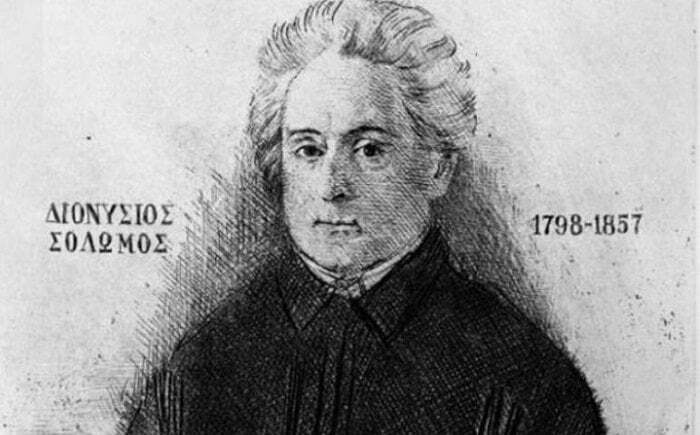HISTORY
HISTORY

The “Hymn to Freedom” was written by Dionysios Solomos at the age of 25 in Zakynthos. The poem was first written in Italian and later, in May 1823, a time of great upheaval for the Greek Revolution, it was also written in Greek.
The song has been the National Anthem of Greece since 1865 and Cyprus since 1966.
Solomos’ poem consists of 158 quatrains. The measure is trochaic with alternations of seven-syllable and eight-syllable verses. The content of the poem is divided into the following parts.
Preface (pp. 1-34). The poet presents the goddess of freedom, recalls the past sufferings of Hellenism, the uprising of slaves, the joy of Hellenism, the hatred of European rulers and the contemptuous indifference of the Greeks for their pro-Turkish feelings.
The description of the Battle of Tripolitsa (pp. 35-74).
The battle of Corinth and the destruction of Dramalis in Dervenakia (pp. 75-87).
The first siege of Messolonghi in 1822 and the drowning of the Turks in the Acheloos river (pp. 88-122).
The war achievements at sea, the burning of the Turkish flagship near Tenedos and the hanging of Gregory V. (pp. 123-138).
Epilogue (pp. 139-158). The poet advises the fighters to get rid of the discord and urges the strongmen of Europe to let Greece be liberated.
The fame of the poem was beyond Zakynthos. In 1824, a part of the whole poem was translated into English and French.
In the Greek revolutionaries’ circles, it was published the same year in Messolonghi, in the newspaper “Hellenic Chronicles” by Iakovos Mager. Several other publications followed the following year, while on October 21, 1825, Spyridonas Trikoupis published the first critique of the poem in the General Gazette of Greece, published in Nafplio.
Between 1828 and 1830, the “Hymn to Freedom” was set to music by the Corfiot composer Nikolaos Mantzaros for a four-part male choir and was heard with enthusiasm at national holidays on the Ionian Islands.
In December 1844, Mantzaros presented a new composition of the poem and submitted it to King Otto, hoping to become the “national song” of Greece.
In 1865, during his visit to Corfu, King George I heard the version of Mantzaros’ composition for wind orchestra by the band of the Corfu Philharmonic Society and was thrilled.
After this Royal Decree of August 4, 1865, it was characterized as an “official national anthem” and its execution was carried out “against all the naval divisions of the Royal Navy”.
Also, the foreign ambassadors were informed, so that the hymn’s execution is also heard on foreign ships in the cases of paying tribute to the King of Greece or the Greek Flag. Since then, the “Hymn to Freedom” by Dionysios Solomos, set to music by Nikolaos Mantzaros, is considered the national anthem of Greece.
As of November 18, 1966, with the Cabinet’s decision 6133, it was established as the national anthem of the Republic of Cyprus.
Armenian Genocide Remembrance Day
On this day, 109 years ago, the genocide of the Armenian people by the Ottoman Empire began, with April 24 being the day of…
April 10, 1826 | The heroic Exodus of Messolonghi
Three years after the failed attempt of Kioutachis and Omer Vryonis to capture Messolonghi, the Sultan had a new plan.
Hellenic Army General Staff (HAGS) | Events for the 83rd Anniversary of the Battle of the Forts
On Sunday, April 7, 2024, the 83rd anniversary of the Battle of the Forts (April 6-9, 1941) was celebrated at “LISSE”, “RUPEL”,…
A reluctant alliance? A different approach to French – Serbian defence relations
It has only been a few months since Croatia started receiving the first of the Rafale fighter jets it ordered from France.
Agamemnon | The new Astute-class HMS nuclear submarine of the Royal Navy
The British Royal Navy has named the newly-built Astute-class nuclear-powered submarine HMS Agamemnon. Doing so, the…
NSPA | Awards first C-sUAS multinational contract in NATO’s history
The NATO Support and Procurement Agency (NSPA) has approved the first Counter-small UAS (C-sUAS) procurement framework agreement…
USA | Signs bill on military aid to Ukraine
US President Joe Biden has signed a bill providing Ukraine with billions of dollars in new aid for its war with Russia, marking a rare…
Armenian Genocide Remembrance Day
On this day, 109 years ago, the genocide of the Armenian people by the Ottoman Empire began, with April 24 being the day of…
United Kingdom | Increase in defence spending
Britain will gradually increase its defence spending to reach 2.5% of GDP by 2030, Prime Minister Rishi Sunak announced…


















0 Comments